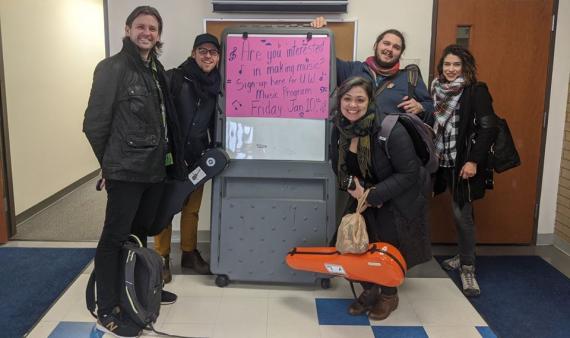Twenty is a magic number in 2020 and a milestone year for a dynamic UW Music program making a difference for children and youth through singing, dancing, and music making of various forms and practices in the public schools of Toppenish and Harrah, and at the Yakama Nation Tribal School in Eastern Washington.
The diverse learners of these schools, including many Mexican-heritage children and students of the Yakama Reservation, are recipients of Music Alive! in the Yakima Valley (MAYV), a dynamic program involving UW students and faculty of Music Education and made possible with funding from the UW College of Arts & Sciences, the School of Music, the Office of Minority Affairs, as well as through the external support of the Jubilation Foundation, the Yamaha Corporation, the Music Teachers National Association, and the Peach Foundation.
“Music Alive! in the Yakima Valley is important to the UW mission of developing responsible global citizens who are also community-conscious leaders”, explains Professor Campbell, founder of the program. “Through cutting-edge scholarship, performance, and pedagogy, students of this project are building bridges as they teach and facilitate learning in music and through music.”
Over the past four years, the program’s attention has been turned to fostering the expressive-creative musical voices of indigenous youth in touch with their Yakama heritage yet also attuned to contemporary popular music, dance, and poetry. The 2020 teaching group consists of three Ph.D. and two M.A. students: Skúli Gestsson, lead, Juliana Cantarelli Vita, Kaity Cassio Igari, Jack Flesher, and Cameron Armstrong (in partnership with YNTS elders Ezilda Winnier and Tony Washines).
The MAYV team now offers a series of annual workshops in collective songwriting at the tribal school. Through day-long intensive experiences, participating students in grades eight through twelve are developing their musical creativity in a collaborative and empowering setting, so that they may document their own stories in their own voices. Through their contributions to the melodic, rhythmic, and linguistic composite of a collective song, students may strengthen their personal, musical, community, and cultural identities as they develop their experiences and perspectives in a shared process.
As the students document this process, they generate songs that can be shared with the tribal community to bring attention to important issues within which they are engaged. Students are encouraged to incorporate indigenous Yakama musical expressions as well as Sahaptin/Ichiskíin language into their song. The MAYV team notes that such a fusion of cultural sensibilities helps to create linkages between the students’ identities as members of both contemporary youth culture and the Yakama Nation.
“The kids are capable of both lives . . . they need to realize they have something to contribute,” says culture teacher and tribal elder Ezilda Winnier. As the project continues, the UW Music Education faculty and students are striving to foster connections with the Yakama community at large, and to partner with additional cultural revitalization efforts in the Toppenish and White Swan areas.
In the words of students in one of their collective-collaborative songs, “For a good vibe, rep your tribe / Gotta keep your culture up to stay alive / Let’s stand together, rep my tribe forever. “ In the 20th year of Music Alive! in the Yakima Valley, there is clear evidence that this UW partnership is continuing to change lives through music, and that the efforts by the Music Education program are sustainable for what they offer all who are involved.
